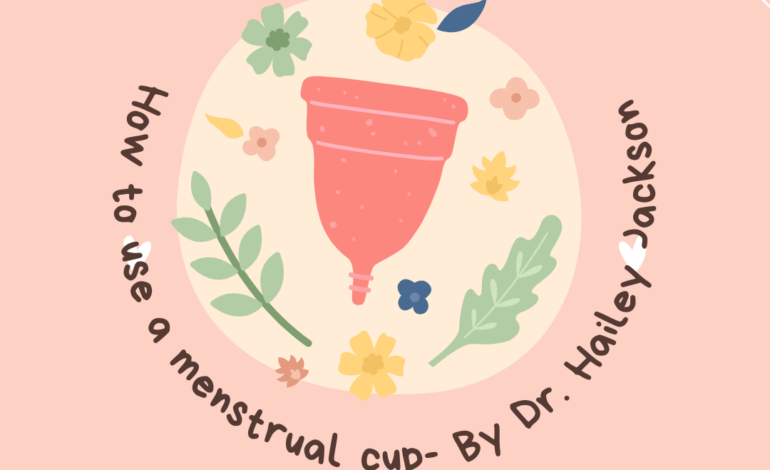How to use a menstrual cup- By Dr. Hailey Jackson

What is a menstrual cup?
A menstrual cup is a reusable feminine hygiene product designed to collect menstrual fluid. It’s inserted into the vagina and can be used instead of disposable tampons or pads. Made from medical-grade silicone, rubber, or elastomer, menstrual cups are environmentally friendly and can be worn for several hours before emptying and cleaning.
What is a menstrual disc?
A menstrual disc is another type of feminine hygiene product used during menstruation. It’s a thin, flexible device made of materials like silicone or elastomer. Unlike a menstrual cup that collects fluid in a cup-like shape, a menstrual disc is disc-shaped and is designed to fit in the vaginal fornix, which is the space beyond the vaginal canal. It collects menstrual fluid in a different way compared to a menstrual cup.
How do you insert a cup?
To insert a menstrual cup:
1. Wash your hands thoroughly.
2. Fold the menstrual cup using one of the common folding methods, like the “C-fold” or “Punch-down fold.”
3. Relax your muscles and find a comfortable position, like feet elevated on a squatty potty, sitting on the toilet, or standing with one leg elevated.
4. Gently separate the labia with one hand and use your other hand to guide the folded cup into your vaginal opening at a slight angle.
5. Push the cup into your vagina until it’s about half an inch to an inch inside.
6. Allow the cup to open fully by rotating it or running a finger around the base.
7. Ensure that the cup is positioned below the cervix and forms a seal against the vaginal walls.
8. Give it a gentle tug to make sure it’s properly positioned and creating a seal.
Remember, it might take a few tries to get the hang of inserting and positioning the cup correctly. If you’re unsure, you can consult the instructions that come with your menstrual cup or seek guidance from others who use them.
Equally as important, how do you remove it?
To remove a menstrual cup:
1. Wash your hands thoroughly.
2. Find a comfortable position, such as squatting or sitting on the toilet.
3. Gently insert your thumb and forefinger into your vagina to locate the base of the cup.
4. Pinch the base of the cup to break the seal that it has formed with the vaginal walls.
5. Slowly and gently wiggle the cup from side to side as you pull it down and out of your vagina.
6. Empty the contents of the cup into the toilet.
7. Rinse the cup with water, or wipe it with a damp cloth if a water source is not readily available.
8. Reinsert the cup using the steps mentioned earlier if you plan to continue using it.
Remember to take your time and be patient when removing the cup, especially if it’s your first time using one. It might take a bit of practice to get comfortable with the process.
Should anyone not use it?
While menstrual cups are safe and suitable for many individuals, there are certain situations in which their use might not be recommended:
1. Anatomy: Some people might have an anatomical variation, such as a particularly low cervix, that could make using a menstrual cup uncomfortable or difficult.
2. Medical Conditions: If you have certain medical conditions like vaginismus, a history of toxic shock syndrome (TSS), or other vaginal infections, it’s advisable to consult a healthcare professional before using a menstrual cup.
3. Allergies or Sensitivities: Individuals with allergies or sensitivities to the materials used in menstrual cups (usually medical-grade silicone or rubber) should avoid using them.
4. Difficulty with Insertion/Removal: Some individuals might find insertion or removal of menstrual cups challenging, especially if they have dexterity issues or difficulties reaching their vaginal area.
5. Intrauterine Device (IUD): There’s a slight risk of accidentally displacing or dislodging an IUD during the insertion or removal of a menstrual cup. It’s recommended to consult a doctor before using both devices simultaneously.
Always consult with a healthcare professional before trying any new menstrual product, especially if you have concerns or existing health conditions. They can provide personalized advice based on your individual circumstances.
Does it hurt?
Using a menstrual cup shouldn’t be painful if it’s inserted correctly and positioned comfortably. However, some individuals might experience mild discomfort or a learning curve during their initial uses. Here are a few reasons why someone might experience discomfort:
1. Improper Insertion: If the cup isn’t inserted properly or the seal isn’t formed correctly, it might cause discomfort or leakage.
2. Size and Fit: Choosing the right size and shape of cup for your anatomy is important. A cup that’s too large or too small might be uncomfortable. www.putacupinit.com is a great resource for sizing recommendations.
3. Sensitivity: Some people might have vaginal sensitivity that makes the cup’s presence noticeable or slightly uncomfortable.
4. Insertion/Removal Technique: Incorrect techniques during insertion or removal could cause discomfort. Learning the correct methods can minimize any discomfort.
5. Anatomical Variations: Some individuals have anatomical variations that could make it harder to find the right positioning for the cup.
6. Muscle Tension: Anxiety or muscle tension during insertion might contribute to discomfort.
If you experience discomfort, it’s a good idea to troubleshoot by trying different folding techniques, adjusting the cup’s position, or experimenting with a different size or brand. If discomfort persists, consult a healthcare professional to rule out any issues or sensitivities.
How long can you leave it in?
Menstrual cups can generally be worn for up to 8 to 12 hours, depending on your flow and the cup’s capacity. However, it’s important to follow the manufacturer’s guidelines and listen to your body’s signals. Here are some key points to keep in mind:
1. Flow: If you have a heavier flow, you might need to empty the cup more frequently to prevent leakage. On lighter days, you can leave it in for the maximum recommended time.
2. Manufacturer’s Instructions: Always follow the guidelines provided by the menstrual cup manufacturer. Some cups might have specific recommendations for usage duration.
3. Comfort: If you start feeling uncomfortable or notice any leakage before the 8-12 hour mark, it’s a sign that the cup is full and needs to be emptied.
4. Overnight: Many people find that they can wear the cup overnight without leakage, but you might want to empty it before going to bed and again in the morning.
5. Hygiene: Even if you’re not at the maximum time limit, consider emptying and cleaning the cup more frequently if you’re in situations where hygiene might be a concern (e.g., public restrooms, camping).
6. TSS Risk: Unlike tampons, there’s a lower risk of toxic shock syndrome (TSS) with menstrual cups. However, it’s still important to follow proper hygiene and not exceed the recommended usage time to minimize any potential risks.
Remember that every individual’s body and flow are different, so you might need to adjust how often you empty the cup based on your own experiences. If you’re unsure, you can start with shorter durations and gradually increase the time as you become more comfortable and confident using the cup.
For more information regarding menstrual cups, reach out via email – hailey@txpelvichealth.com or to schedule an appointment for menstrual pain or pelvic floor muscle tension, call 903-962-2600.













